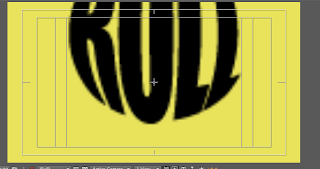In Photoshop we need to create something that is appropriate for After Effects. The resolution needs to be 72 dpi as it is for screen based design. We will also be working in RGB mode. The document size will be measured in pixels, so that we can compare to our After Effects composition.
If you set the document to film and video mode then you will find that there are similar options as After Effects. If we choose the same setting then it will be exactly the same as our composition.
When producing a Photoshop document for video you are given guides. The outer lines are to represent the 'action safe zone'. Anything you position inside these lines will be viewable however the video is viewed. Keep anything significant within these zones.
The inner lines are to represent the 'title safe zone'. Any text should be kept within these guides.
You can also turn these guides on in After Effects by selecting it on the drop down menu along the bottom of the composition box.
Save your Photoshop files as PSD files to allow you to do anything you want to them when you import the to After Effects. When working with Photoshop artwork it is very important that it is the right size so that it doesn't become pixelated.
If you import a file as 'footage' then it will occupy just one layer.
When the file is imported it appears as an asset in your project panel. Here it tells you the name and also the path of the file. This lets you know that After Effects works with images in the same way as InDesign. It doesn't import the actual image but establishes a link to the file. Therefore it is important to keep all of your original images together in the same folder.
You can just drag it into your composition window.
If you want to adjust your composition while your working on it, such as changing the background colour, you click on composition, composition settings.
If you want your image to be dead centre in the frame then drag it into the layers panel.
You can work with layers in Photoshop and continue to use these layers in After Effects. Such as this word 'shatter' produced separately on Photoshop.
This type of image needs to be imported as a composition.
If you look at the project panel, this type of file looks different to a footage file. This is because there is a different Photoshop file for every layer.
We now have two compositions to work with. Any After Effects project can include more than one composition. Double click on a composition to work with it.
Each layer from Photoshop is now in your layers panel, allowing you to animate them all individually.
The first thing to do is to add a position keyframe on every layer by selecting all layers, pressing the P shortcut for position. Then click on the stopwatch symbol while all layers are still selected to add you keyframes. Make sure your time ruler is where you want the keyframes to start.
You then move the time ruler to when you want the movement to end to add another keyframe. Then move the pieces manually.
If you want to change the speed of the pieces from one another then simply move around the keyframes. This also alters when the pieces stop and start to move.
You can also change the anchor points to alter which path each piece will take.
We have now imported an image to scale. Each letter is on a different layer, but are all centred around the same anchor point. This means that you can rotate, change the scale etc together or individually but around the same central anchor point.
When importing if you choose 'composition- retain layer sizes' then the anchor point is central to each of the layers actual content. This means that when rotating or scaling etc one of the letters, the anchor point is central to it. Which you use is simply down to which one is most useful to you.
Just as in Photoshop when using Illustrator you adjust the settings to a the video and film preset.
The file appears different to if you were working in print.
We are going to import the illustrator file as footage.
When we import an illustrator file, After Effects rasterizes the artwork so it becomes pixelated when you enlarge it.
If you select the 'shy switch' on the layers panel then the content will appear in your composition, but not in your timeline. This makes things neater and easier to work with. You will also have to select the shy button to make them disappear. If you uncheck it they will reappear.
you can also change the quality of your video layer by layer by selecting these options on the layer panel.
The motion blur switch applies a motion blur any movement on that layer. The faster the movement, the more noticeable the motion blur. There is also a main switch at the top of the layers panel that enables a blur to the overall video. This applies to rotation, scale and position.
This increases the ram preview time so that it is a good idea to turn this off when previewing.
This switch is the continuously rasterize effect, this means that it is rasterized frame by frame which keeps the edges sharp. Effectively it is like keeping a vectored image. Having a lot of Illustrator files would slow down the ram preview. To stop this you could uncheck this while working and check it again when exporting the video.
A useful way to check that you have all of your files together is when saving check the collect files option after saving, and then selecting the folder that contains all of the files used in your video.










































No comments:
Post a Comment